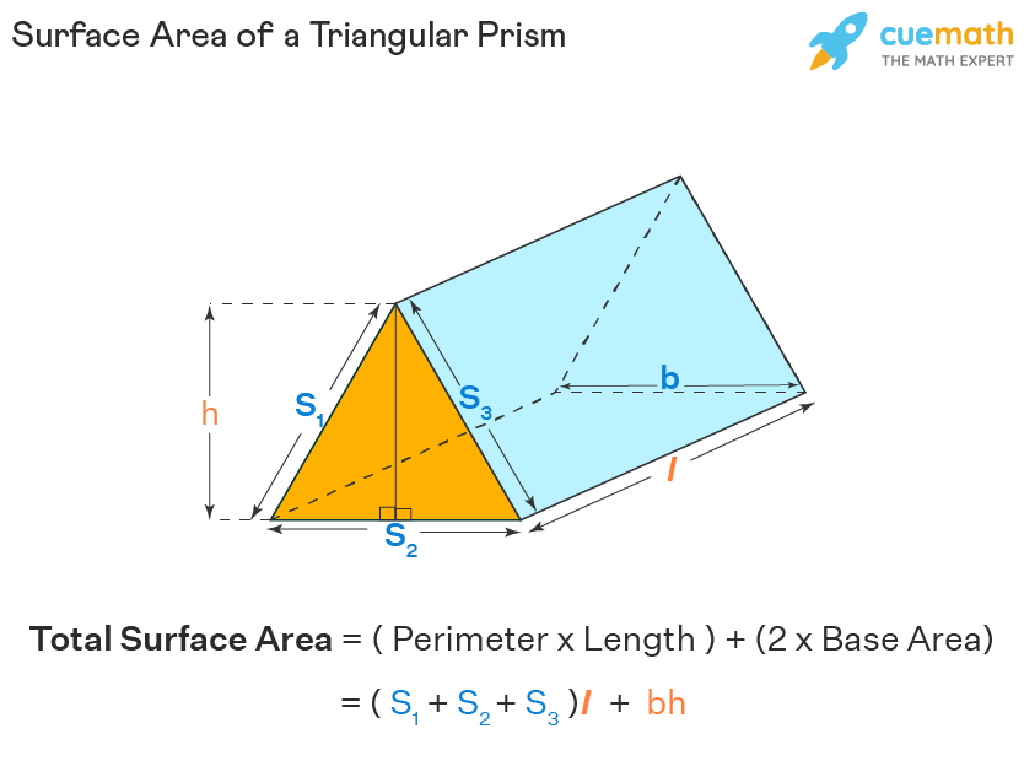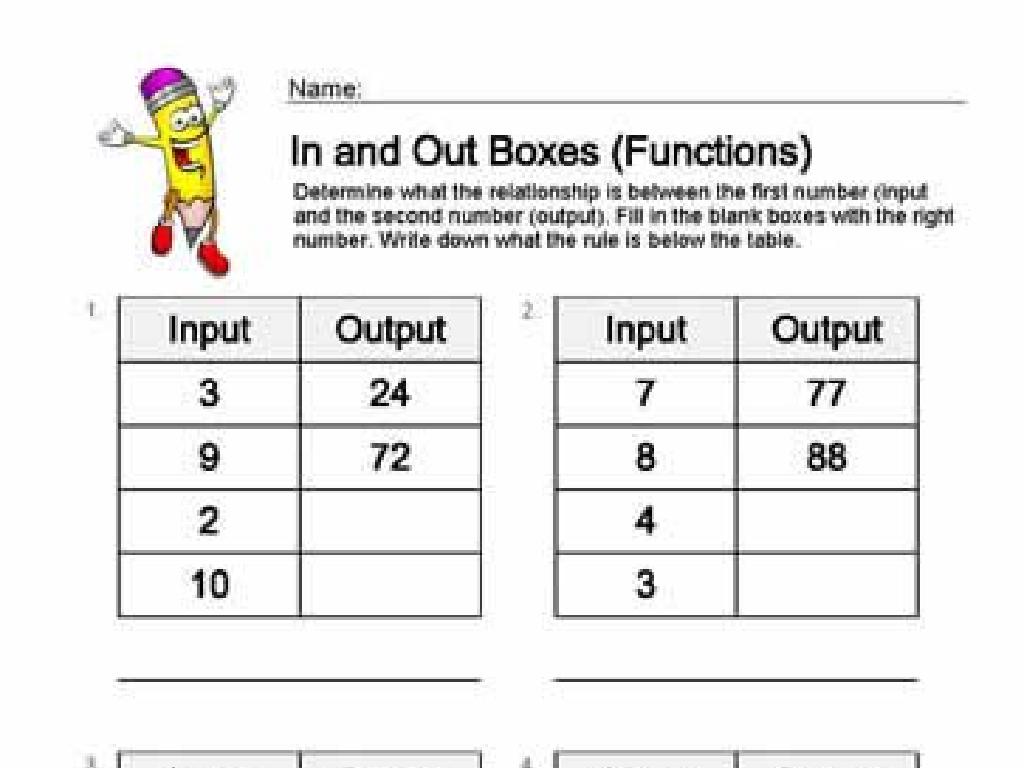Integers On Number Lines
Subject: Math
Grade: Seventh grade
Topic: Integers
Please LOG IN to download the presentation. Access is available to registered users only.
View More Content
Exploring Integers on a Number Line
– Integers: Positive and Negative
– Integers include whole numbers and their opposites, e.g., -3, -2, -1, 0, 1, 2, 3.
– Visualizing Integers on a Line
– A number line helps us see the position of integers relative to each other.
– Plotting Points: Examples
– Example: Plot -3 and 4 on a line to compare their positions.
– Number Line: A Math Tool
|
Begin with a brief introduction to integers, emphasizing that they consist of positive numbers, negative numbers, and zero. Explain that a number line is a visual representation that helps us understand these concepts better. Demonstrate how to plot integers on a number line, using both positive and negative examples. Encourage students to think of the number line as a valuable tool in mathematics for comparing and ordering integers, as well as for performing operations with them in future lessons. Provide several examples for students to plot on their own number lines.
Exploring Integers on Number Lines
– Define integers
– Integers include all whole numbers and their negatives
– Whole numbers vs. Integers
– Whole numbers are non-negative; integers can be negative
– Real-life integer examples
– Elevator floors below ground, temperatures below zero
– Integers on a number line
– Visualize integers as points on a line, with zero as the center
|
Begin with a definition of integers, emphasizing that they include both positive and negative whole numbers, as well as zero. Clarify the difference between whole numbers (which are always non-negative) and integers (which can be negative). Provide relatable examples of integers from everyday life, such as floors in a building below ground level or temperatures below freezing, to help students understand the concept. Finally, introduce the concept of a number line and show how integers are represented on it, with zero as the central point. This visual representation will be crucial for understanding how to perform operations with integers in future lessons.
Positive and Negative Numbers on a Number Line
– Defining positivity and negativity
– Positive numbers are above zero, negative numbers are below.
– Real-world examples
– Earnings are positive; debts are negative.
– Identifying numbers on a number line
– Positive to the right of zero, negative to the left.
– Practice with examples
– Use examples like temperatures and elevations.
|
This slide introduces students to the concept of positive and negative numbers, crucial for understanding integers. Start by defining what makes a number positive (greater than zero) or negative (less than zero). Provide relatable examples such as money earned (positive) and debts (negative), or temperatures above/below freezing. Show how these numbers are represented on a number line, with positive numbers to the right of zero and negative numbers to the left. Encourage students to practice placing numbers on a number line using real-world examples like temperatures (above/below zero) or elevations (above/below sea level). This will help them visualize and better understand the concept of integers in a number line context.
Number Line Basics
– Components of a number line
– A number line includes negative and positive numbers, and is divided by equal intervals.
– How to plot points
– To plot a point, find the value on the line and mark it.
– Zero: The neutral point
– Zero is the central point where positive numbers start to the right and negatives to the left.
– Practice plotting integers
|
This slide introduces the fundamental concepts of a number line, which is a visual representation of numbers in order. Students should understand that a number line is composed of positive and negative numbers, with each point representing a unique value. Emphasize the importance of zero as the neutral point that separates positive and negative values. Encourage students to practice plotting points on a number line to gain familiarity with the concept of value placement and direction. This will be the foundation for understanding more complex integer operations in future lessons.
Plotting Integers on a Number Line
– Plotting positive integers
– Start at zero, move right for positive numbers
– Plotting negative integers
– Start at zero, move left for negative numbers
– Practice with class examples
– Use given integers to plot on a number line together
– Understanding integer positions
– Recognize that numbers to the right are greater
|
This slide is aimed at teaching students how to correctly plot both positive and negative integers on a number line. Begin by explaining that all positive integers are found to the right of zero on a number line. Each step to the right increases the value by one. Conversely, negative integers are located to the left of zero, and each step to the left decreases the value by one. Provide practice examples for the class to plot together, such as 3, -1, 4, and -5, and discuss as a group. Emphasize that integers further to the right on the number line are always greater than those to the left. This will help students visualize and understand the order of integers. For the activity, consider having students come to the board to plot points, or provide them with individual number lines to practice on.
Comparing and Ordering Integers
– Compare integers on a number line
– Use the number line to visualize which integers are larger or smaller.
– Order integers least to greatest
– Place integers in a sequence based on their value.
– Class exercise: arrange integers
– Students will practice arranging a given set of integers.
|
This slide introduces the concept of comparing and ordering integers using a number line, which is a visual tool that helps students understand the relative position of numbers. Start by explaining how to determine which integers are greater or less by their position on the number line. Then, guide students on how to order a group of integers from the smallest to the largest. For the class exercise, provide a set of integers and have students arrange them on a number line they draw. This hands-on activity will reinforce their understanding of the concepts. Possible sets for the activity could include: {-3, 1, 4, -1}, {2, -5, 0, 3}, or {-2, -6, 5, -1}. Encourage students to explain their reasoning as they arrange the numbers.
Integers in Mathematical Operations
– Adding integers on a number line
– Move right to add a positive integer, left for a negative
– Subtracting integers on a number line
– To subtract, reverse the direction of the integer’s sign
– Practice with simple problems
– Solve example problems: -3 + 4, 5 – (-2)
– Class activity: Integer operations
– Students will solve problems on the board
|
This slide introduces students to the concept of performing basic arithmetic operations with integers using a number line. Emphasize the directionality of adding and subtracting on the number line: adding moves to the right, subtracting to the left. Provide clear examples for both operations. For practice, present simple problems that reinforce these concepts. The class activity involves students coming up to the board to solve problems, fostering engagement and allowing for immediate feedback. Prepare a set of diverse problems of varying difficulty to cater to different skill levels within the class.
Class Activity: Integer Number Line Race
– Divide into small groups
– Receive integer cards
– Place integers on number line
Each group races to place their cards in the correct order on the number line.
– Discuss results and corrections
Review each group’s placement and clarify any errors.
|
This interactive activity is designed to help students understand the placement of integers on a number line. By dividing the class into small groups, students can collaborate and challenge each other. Each group will receive a set of integer cards which they will race to place on a large number line in the correct order. After the race, lead a class discussion to go over the results. This is an opportunity to address any misconceptions and reinforce the concept of integer order. Possible variations of the activity could include using negative integers, having a relay race where each student places one integer at a time, or timing each group to add a competitive element.
Wrapping Up: Integers on Number Lines
– Recap today’s integer concepts
– Why mastering integers matters
– Integers are foundational for advanced math topics.
– Homework: Integer worksheet
– Complete the worksheet on plotting and identifying integers.
– Bring questions next class
– Review your work and note any uncertainties.
|
As we conclude today’s lesson, it’s crucial to review the key concepts covered about integers and their placement on number lines. Emphasize the importance of understanding integers as they are the building blocks for algebra and higher-level mathematics. For homework, students are assigned a worksheet that includes exercises on plotting integers on a number line and identifying the value of integers from given plots. This practice will reinforce their learning from today’s class. Encourage students to attempt all problems and bring up any questions or difficulties they encounter in the next session, fostering a continuous learning cycle.






